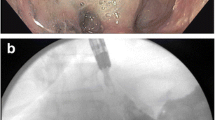Abstract
Background
The use of fully covered self-expandable metallic stents (FCSEMS) has opened the door to treat stenosis in the post-bariatric stomach. We hypothesized that endoscopically securing a FCSEMS would be technically feasible, effective, and safe for > 30-day dwell time.
Objectives
To assess the technical feasibility, clinical efficacy, and safety of endoscopically secured FCSEMS in the stomach for > 30 days.
Methods
A retrospective review (September 2016 to April 2018) of consecutive patients who underwent FCSEMS suturing in the stomach at a single academic institution was reviewed. Technical success, stent dwell time, symptoms, and adverse events were recorded.
Results
Fifteen patients (median age of 49 (31–70)) were included. Stents were inserted for gastrojejunal (GJ) stricture or gastric stenosis in 9/15 and 6/15 of patients, respectively. All procedures were technically successful (100%). Immediate and short-term clinical success (prior to stent removal) was 100% in patients who did not have stent migration. Stent migration was seen in 3 cases (20%) after a median dwell time of 211 days. However, 2/3 (66.6%) had not attended their scheduled removal. Recurrence of symptoms after stent removal was seen in 53.3% of patients with 40% undergoing repeat stenting. Median stent dwell was 117 (30–342) days. Sixty percent and 33% of patients had stent dwell of at least 90 and 180 days, respectively.
Conclusions
A FCSEMS, if secured, may be safe and effective for even > 90-day dwell time in the post-bariatric stomach and may result in long-term clinical success for GJ stricture after stent removal.



Similar content being viewed by others
References
Kumbhari V, Cai JX, Schweitzer MA. Endoscopic management of bariatric surgical complications. Curr Opin Gastroenterol. 2015;31(5):359–67.
Burgos AM, Csendes A, Braghetto I. Gastric stenosis after laparoscopic sleeve gastrectomy in morbidly obese patients. Obes Surg. 2013;23(9):1481–6.
Parikh A, Alley JB, Peterson RM, et al. Management options for symptomatic stenosis after laparoscopic vertical sleeve gastrectomy in the morbidly obese. Surg Endosc. 2012;26(3):738–46.
Rebibo L, Hakim S, Dhahri A, et al. Gastric stenosis after laparoscopic sleeve gastrectomy: diagnosis and management. Obes Surg. 2016;26(5):995–1001.
Garcia-Garcia ML, Martin-Lorenzo JG, Liron-Ruiz R, et al. Gastrojejunal anastomotic stenosis after laparoscopic gastric bypass. Experience in 280 cases in 8 years. Cirugia espanola. 2014;92(10):665–9.
Ribeiro-Parenti L, Arapis K, Chosidow D, et al. Gastrojejunostomy stricture rate: comparison between antecolic and retrocolic laparoscopic Roux-en-Y gastric bypass. Surg Obes Relat Dis. 2015;11(5):1076–84.
Eloubeidi MA, Talreja JP, Lopes TL, et al. Success and complications associated with placement of fully covered removable self-expandable metal stents for benign esophageal diseases (with videos). Gastrointest Endosc. 2011;73(4):673–81.
Eubanks S, Edwards CA, Fearing NM, et al. Use of endoscopic stents to treat anastomotic complications after bariatric surgery. J Am Coll Surg. 2008;206(5):935–8. discussion 8-9
Thomas T, Abrams KR, Subramanian V, et al. Esophageal stents for benign refractory strictures: a meta-analysis. Endoscopy. 2011;43(5):386–93.
Sharaiha RZ, Kim KJ, Singh VK, et al. Endoscopic stenting for benign upper gastrointestinal strictures and leaks. Surg Endosc. 2014;28(1):178–84.
Diana M, Swanström LL, Halvax P, et al. Esophageal covered stent fixation using an endoscopic over-the-scope clip. Mechanical proof of the concept and first clinical experience. Surg Endosc. 2015;29(11):3367–72.
Vanbiervliet G, Filippi J, Karimdjee BS, et al. The role of clips in preventing migration of fully covered metallic esophageal stents: a pilot comparative study. Surg Endosc. 2012;26(1):53–9.
Rieder E, Dunst CM, Martinec DV, et al. Endoscopic suture fixation of gastrointestinal stents: proof of biomechanical principles and early clinical experience. Endoscopy. 2012;44(12):1121–6.
Kantsevoy SV, Bitner M. Esophageal stent fixation with endoscopic suturing device (with video). Gastrointest Endosc. 2012;76(6):1251–5.
Ngamruengphong S, Sharaiha RZ, Sethi A, et al. Endoscopic suturing for the prevention of stent migration in benign upper gastrointestinal conditions: a comparative multicenter study. Endoscopy. 2016;48(9):808.
Agnihotri A, Barola S, Hill C, et al. An algorithmic approach to the management of gastric stenosis following laparoscopic sleeve gastrectomy. Obes Surg. 2017;27(10):2628–36.
Khashab MA, Besharati S, Ngamruengphong S, et al. Refractory gastroparesis can be successfully managed with endoscopic transpyloric stent placement and fixation (with video). Gastrointest Endosc. 2015;82(6):1106–9.
Hill C, Khalil BK, Barola S, et al. Inversion technique for the removal of partially covered self-expandable metallic stents. Obes Surg. 2018;28(1):161–8.
Bhayani NH, Swanstrom LL. Endoscopic therapies for leaks and fistulas after bariatric surgery. Surg Innov. 2014;21(1):90–7.
Saumoy M, Schneider Y, Zhou XK, et al. A single-operator learning curve analysis for the endoscopic sleeve gastroplasty. Gastrointest Endosc. 2018;87(2):442–7.
Hill C, El Zein M, Agnihotri A, et al. Endoscopic sleeve gastroplasty: the learning curve. Endosc Int Open. 2017;5(9):E900–e4.
Author information
Authors and Affiliations
Corresponding author
Ethics declarations
Ethical Approval Statement
For this type of study, formal consent is not required.
Informed Consent Statement
Informed consent does not apply.
Conflict of Interest
Mouen A Khashab is on the medical advisory board for Boston Scientific and Olympus America and is a consultant for Boston Scientific, Olympus America, and Medtronic. Anthony N Kalloo is a founding member, equity holder, and consultant for Apollo Endosurgery. Vivek Kumbhari is a consultant for Medtronic, Reshape Lifesciences, Boston Scientific, and Apollo Endosurgery. He also receives research support from ERBE USA and Apollo Endosurgery. All the other authors have nothing to disclose.
Additional information
Publisher’s Note
Springer Nature remains neutral with regard to jurisdictional claims in published maps and institutional affiliations.
Electronic supplementary material
Video 1
– Video demonstration of the stent suturing process (MP4 296,017 kb)
Rights and permissions
About this article
Cite this article
Fayad, L., Simsek, C., Oleas, R. et al. Safety and Efficacy of Endoscopically Secured Fully Covered Self-Expandable Metallic Stents (FCSEMS) for Post-Bariatric Complex Stenosis. OBES SURG 29, 3484–3492 (2019). https://doi.org/10.1007/s11695-019-04021-0
Published:
Issue Date:
DOI: https://doi.org/10.1007/s11695-019-04021-0




